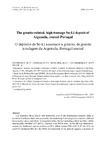Mostrar o rexistro simple do ítem
The granite-related, high-tonnage Sn-Li deposit of Argemela, central Portugal
| dc.contributor.author | Inverno, Carlos | |
| dc.contributor.author | Ferraz, Paulo | |
| dc.contributor.author | Moreira, M. | |
| dc.contributor.author | Guimarães, Fernanda | |
| dc.contributor.author | Filipe, Augusto | |
| dc.date.accessioned | 2020-01-23T12:00:36Z | |
| dc.date.available | 2020-01-23T12:00:36Z | |
| dc.date.issued | 2019 | |
| dc.identifier.citation | Cadernos do Laboratorio Xeolóxico de Laxe: Revista de xeoloxía galega e do hercínico peninsular, ISSN 0213-4497, Nº 41, 2019, páxs. 201-256 | es_ES |
| dc.identifier.issn | 0213-4497 | |
| dc.identifier.uri | http://hdl.handle.net/2183/24754 | |
| dc.description.abstract | [Abstract] The Argemela Sn-Li quartz vein stockwork, east of the Panasqueira tungsten mine, is hosted in Cambrian slates and greywacke. An underlying Variscan granitic cupola is inferred from spotted slates and albitic microgranite dykes, the last including a thick modified albitic microgranite, enriched in F and Li, exposed some 500 m away, on the hill top. Inferred resources for shallowest deposit portion are 20.1 million tonnes (Mt) at 0.1-0.2% Sn, 0.2% Li and 0.1% (estimate) Rb, but the 650-m vertical-extent of the deposit suggests a resource of >200 Mt (with identical grades). The hydrothermal paragenetic sequence is amblygonitemontebrasite (mostly montebrasite) The hydrothermal paragenetic sequence is amblygonitemontebrasite (mostly montebrasite) (Stage I)-quartz I-II-cassiterite (with columbite-tantalite inclusions)-arsenopyrite I-carbonate I-white mica I -chlorite I-fluorite-apatite-rutile (Stage II)- white mica II-molybdenite- tourmaline- carbonate II-quartz III-arsenopyrite II-sphalerite-stannite-chalcopyrite-pyrite- pyrrhotite-chlorite II (Stage III)-covellite- vivianite-goethite/lepidocrocite (Stage IV). Amblygonite-montebrasite is the main Li carrier; Sn is evenly distributed between cassiterite and stannite; Rb is mostly in white mica (with 0.25-1.23 wt % Rb2O in the hill-top albitic microgranite). Primary aqueous, 1-3 um-wide fluid inclusions in the deposit in quartz I, carbonate I, apatite and cassiterite growth zones yield overall salinities and homogenisation temperatures of 7.2-19.1 wt % NaCl equiv. and 290-360ºC, respectively. The trace concentrations (electronic microprobe analysis) in quartz vein cassiterite reach 1.95 wt % Nb, 0.39 wt % Fe, 0.13 wt % Ti, and low/negligible values of Sb, Zn, As, Ag and Bi showing its granite-hydrothermal affiliation. Fe-poor and Fe-rich sphalerite (lower-intermediate and upper deposit parts) contain 1.0-1.6 and 7.9-9.4 wt % Fe, 64.3-66.0 and 55.9-57.2 wt % Zn, 0.4-0.5 and 0.9-1.1 wt % Cd, respectively. The sphaleritestannite geothermometer yields temperatures of 245-297ºC. Following higher temperature amblygonite-montebrasite deposition (Stage I), hydrothermal fluids (aCl-=0.25 m), related to the hidden granitic cupola, at a mean pressure-corrected (50 MPa) temperature of 350ºC, were responsible for Stage II minerals deposition. Calculated cassiterite deposition from Sn chloride complexes occurred likewise, from probable magmatic-hydrothermal fluids, at fO2 = 10-34 -10-32 atm and pH=3.5-4. Cassiterite deposition mechanisms were oxidation, mixing, neutralisation, possible aCl- increase, and cooling. Later Fe-poor sphalerite (+kesterite/ferrokesterite) and Fe-rich sphalerite (+stannite) deposited at higher and lower fS2, respectively, the latter probably at a higher fO2 (Stage III). The uniqueness of Argemela system with abundant amblygonite-montebrasite in hydrothermal quartz tin veins may be related to an extreme fractionated F-, Li- and P-rich granitic magma. After the emplacement of the granite/ albitic microgranite dykes, an emerging pegmatitic fluid was unable, possibly due to insufficient depth, to form pegmatites but only modified the hill-top albitic microgranite. As a consequence, the system, where mixing of high- and low-salinity magmatic fluids probably occurred, remained very enriched in F, Li and P and by the time the hydrothermal stockwork developed amblygonite-montebrasite (Stage I) was the first mineral to deposit abundantly before Stage II minerals deposition in those Argemela Sn-Li quartz veins. | es_ES |
| dc.language.iso | eng | es_ES |
| dc.publisher | Universidade da Coruña, Servizo de Publicacións | es_ES |
| dc.relation.uri | https://doi.org/10.17979/cadlaxe.2019.41.1.5823 | es_ES |
| dc.subject | Granite-related | es_ES |
| dc.subject | High-tonnage | es_ES |
| dc.subject | Sn-Li stockwork quartz veins | es_ES |
| dc.subject | Amblygonitemontebrasite | es_ES |
| dc.subject | Cassiterite | es_ES |
| dc.subject | Th=290-360ºC | es_ES |
| dc.subject | 7-19 wt % NaCl equiv | es_ES |
| dc.subject | Argemela | es_ES |
| dc.subject | Portugal | es_ES |
| dc.title | The granite-related, high-tonnage Sn-Li deposit of Argemela, central Portugal | es_ES |
| dc.title.alternative | O depósito de Sn-Li associado a granito, de grande tonelagem da Argemela, Portugal central | es_ES |
| dc.type | info:eu-repo/semantics/article | es_ES |
| dc.rights.access | info:eu-repo/semantics/openAccess | es_ES |
| UDC.journalTitle | Cadernos do Laboratorio Xeolóxico de Laxe: Revista de xeoloxía galega e do hercínico peninsular | es_ES |
| UDC.volume | 41 | es_ES |
| UDC.startPage | 201 | es_ES |
| UDC.endPage | 256 | es_ES |






